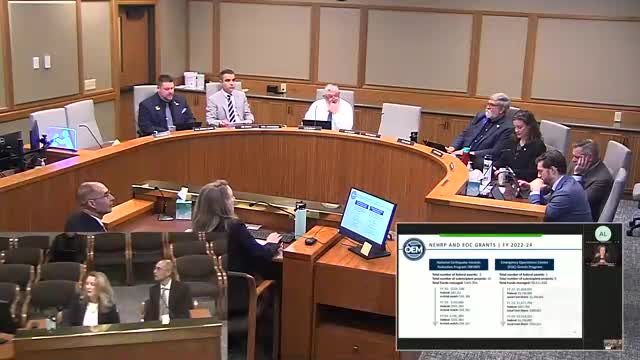Oregon allocates $8.4M for enhanced emergency response and earthquake hazard reduction
April 07, 2025 | Public Safety, Ways and Means, Joint, Committees, Legislative, Oregon
This article was created by AI summarizing key points discussed. AI makes mistakes, so for full details and context, please refer to the video of the full meeting. Please report any errors so we can fix them. Report an error »

In a recent meeting of the Joint Committee on Ways and Means Subcommittee on Public Safety, Oregon legislators discussed critical funding and strategies aimed at enhancing the state's emergency response capabilities. The focus was primarily on the National Earthquake Hazard Reduction Program (NEHIRP) and the Emergency Operations Center (EOC) grants, which together allocate significant resources to bolster seismic safety and improve emergency infrastructure across Oregon.
The NEHIRP has managed to secure $401,704 for earthquake hazard reduction efforts, while the EOC grants program has provided an impressive $8.4 million to enhance emergency operation infrastructure. This funding is essential as the demand for emergency response has been steadily increasing, evidenced by the governor's issuance of 307 disaster-related executive orders since February 2003. These orders have addressed a variety of emergencies, including wildfires, winter storms, flooding, and the COVID-19 pandemic, highlighting the state's ongoing commitment to community safety and resource mobilization during crises.
The meeting also highlighted the three disaster declarations made in 2025, which include federally declared wildfires and state disasters in Douglas, Coos, Curry, and Harney Counties. These declarations underscore the importance of Oregon's emergency support functions (ESFs), which are crucial for coordinating disaster response across 18 key areas, including transportation, law enforcement, and health services.
Additionally, the state has updated its emergency operations plan to ensure effective coordination during disasters. The recovery functions established by the state aim to guide long-term recovery efforts across various sectors, including economic recovery and community planning. Oregon's selection for FEMA's State Technical Assistance Recovery Strategy program further emphasizes the state's proactive approach to disaster recovery, allowing for the incorporation of lessons learned from past events into future planning.
As the Oregon Office of Emergency Management (OEM) operates independently, legislators are keen to understand the challenges faced by the agency in managing these emergency support functions. The discussions reflect a broader commitment to enhancing Oregon's resilience in the face of increasing natural disasters and emergencies, ensuring that communities are better prepared for future challenges.
The NEHIRP has managed to secure $401,704 for earthquake hazard reduction efforts, while the EOC grants program has provided an impressive $8.4 million to enhance emergency operation infrastructure. This funding is essential as the demand for emergency response has been steadily increasing, evidenced by the governor's issuance of 307 disaster-related executive orders since February 2003. These orders have addressed a variety of emergencies, including wildfires, winter storms, flooding, and the COVID-19 pandemic, highlighting the state's ongoing commitment to community safety and resource mobilization during crises.
The meeting also highlighted the three disaster declarations made in 2025, which include federally declared wildfires and state disasters in Douglas, Coos, Curry, and Harney Counties. These declarations underscore the importance of Oregon's emergency support functions (ESFs), which are crucial for coordinating disaster response across 18 key areas, including transportation, law enforcement, and health services.
Additionally, the state has updated its emergency operations plan to ensure effective coordination during disasters. The recovery functions established by the state aim to guide long-term recovery efforts across various sectors, including economic recovery and community planning. Oregon's selection for FEMA's State Technical Assistance Recovery Strategy program further emphasizes the state's proactive approach to disaster recovery, allowing for the incorporation of lessons learned from past events into future planning.
As the Oregon Office of Emergency Management (OEM) operates independently, legislators are keen to understand the challenges faced by the agency in managing these emergency support functions. The discussions reflect a broader commitment to enhancing Oregon's resilience in the face of increasing natural disasters and emergencies, ensuring that communities are better prepared for future challenges.
View full meeting
This article is based on a recent meeting—watch the full video and explore the complete transcript for deeper insights into the discussion.
View full meeting
